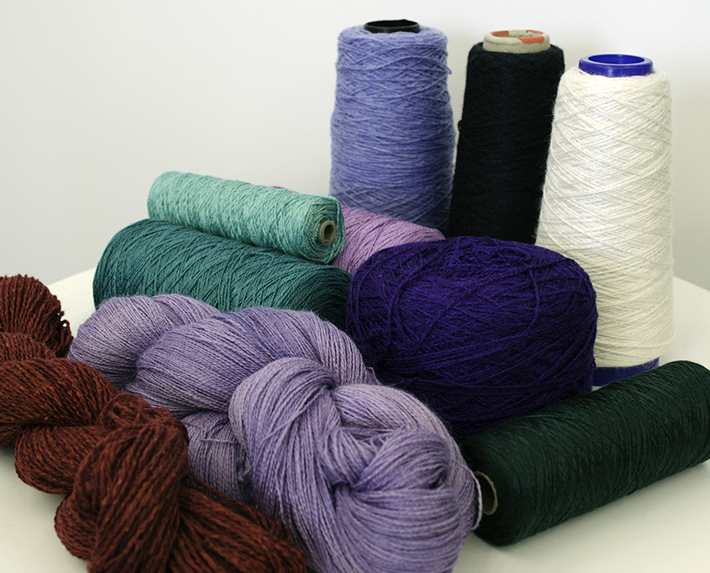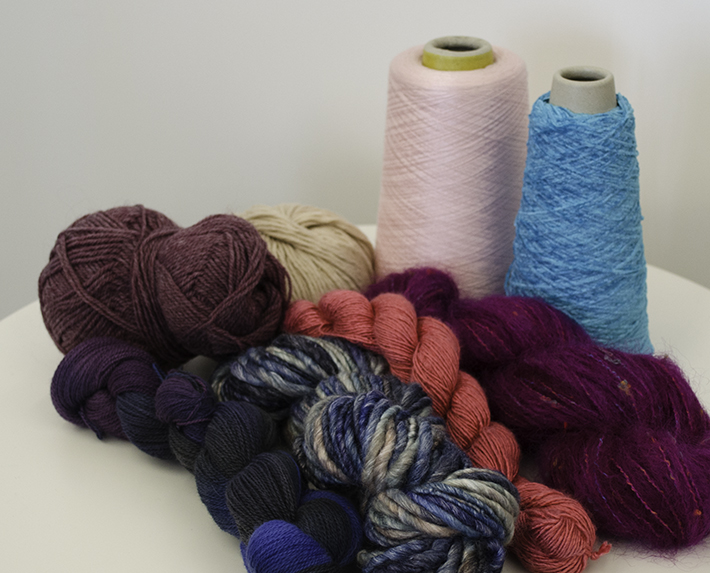A scarf is one of the most enduringly popular weaving projects. It has two main virtues: firstly, that a long, narrow rectangle of cloth is easy to weave, and, secondly, that you can always find a use for a scarf, whether you decide to keep it yourself or give it away. Here are seven tips to help you tackle weaving a scarf for the first time with confidence.

1. Keep it simple
When you make your first anything, it is tempting to try and do everything you have dreamed of all at once. Resist that temptation: no one wants to hear your screaming.
You can keep it simple by weaving a tried and tested project, but you don’t need to. A straight draw on four or eight shafts is a really simple threading which will allow you to weave all sorts of different twills, for example.

If you have fallen in love with a complex weave structure, then, by all means, go ahead and try it; but aim to simplify other aspects of the project, so that – for instance – you aren’t trying to weave it with a very fine or very slippery yarn.
2. Choose your yarn with care
Be sure to choose a yarn that you can be confident will weave successfully, either one that is specially designed for weaving or one which is recommended by other weavers. Just because it is a lovely color and on a fantastic offer at your local yarn store doesn’t mean that it will work well on the loom.
Some knitting yarns can be used very successfully in weaving but many are tricky to handle – especially as warp – and don’t give good results, either because of their structure or because of the way they have been dyed. Space-dyed yarns, in particular, look wonderful in the skein but need special handling to weave well.

Ideal for a first scarf: lambswool, Merino, cotton, and Tencel are all available in many beautiful colors

Save these for later: stretchy, slippery, fuzzy, ultra-fine or space-dyed yarns
If you want to be really confident with color, take time to experiment. My no-fail tip for choosing yarn colors is to pick two different shades of the same hue: use the darker one in the warp and the lighter in the weft. It will be fabulous.
3. Buy enough yarn
Do your sums before you shop. A good length for a scarf warp is 3 yards: that will allow you to weave a wee sample first and also leave enough for a fringe at either end. How many 3-yard ends you need will depend on the appropriate sett for your yarn and the width you want your scarf to be. A rough-and-ready formula for the total length of warp yarn needed is scarf width x 1.1 x sett x warp length.
You will generally need slightly less weft than warp for two reasons: you don’t need to allow for the fringes and waste yarn in the weft, and a scarf tends to drape better if it has slightly more ends per inch than picks per inch. It is also very easy to improvise in the weft: don't have quite enough yarn? Add a bold contrasting stripe at one end of your scarf.
4. Take it slow
Weaving is not a sprint and there are no prizes for finishing first. Really, there isn’t.
You can take all the time you need, so slow down and be patient with yourself and your yarn. Weaving is not just about throwing the shuttle: the processes of dressing the loom are all part of the pleasure of creating something by hand. Relax and let each step have your full attention.
5. Keeping track
If you have wound a warp for a single scarf then you don’t really need to keep track of how much you have woven, except for the thrill of seeing the inches add up. It is useful, however, to know just how much you have done and how much there is left to go.
Weavers have several tricks for doing this. I favor paper tape, cut to the length I plan to weave and marked in divisions appropriate to the project, e.g. 20 cm, 12" etc. I pin the tape to the surface of the cloth, advancing the pins as I advance the warp so that the tape doesn’t get wound onto the cloth beam.

Measuring your weaving while it is on the loom is also a useful way to compare the dimensions of the unfinished piece with its finished state – keep notes of each project you tackle and you will gradually build up your understanding of the way fiber and weave structure interact.
6. Don’t forget the finish
When you cut your scarf from the loom there are several things you may want to do, such as twisting the ends of the warp into a neat fringe. You also need to carry out the all-important wet finishing to turn your stiff web into a lovely supple fabric which will be a pleasure to wear.
7. It’s your first scarf not your last
It won’t be perfect. But that’s OK. Keep on weaving scarves and with each one you will gain a little more experience and become that little bit more skilled. And before you know it you will be weaving that complex structure in gossamer-fine silk without batting an eye.

Where do you purchase the paper tape? (great tip for a newbie0
This will be my first try